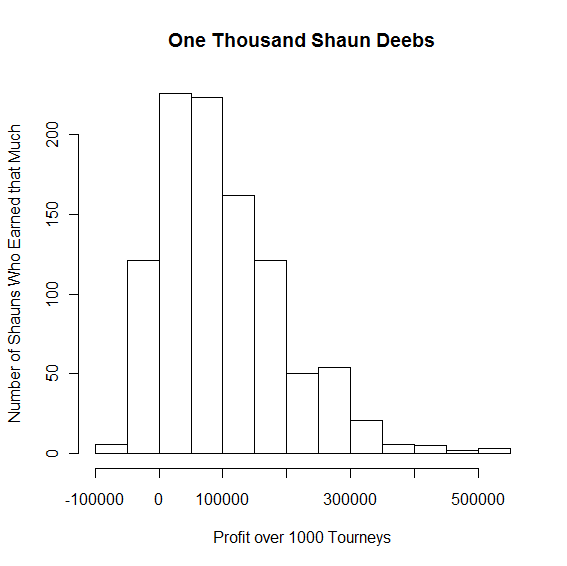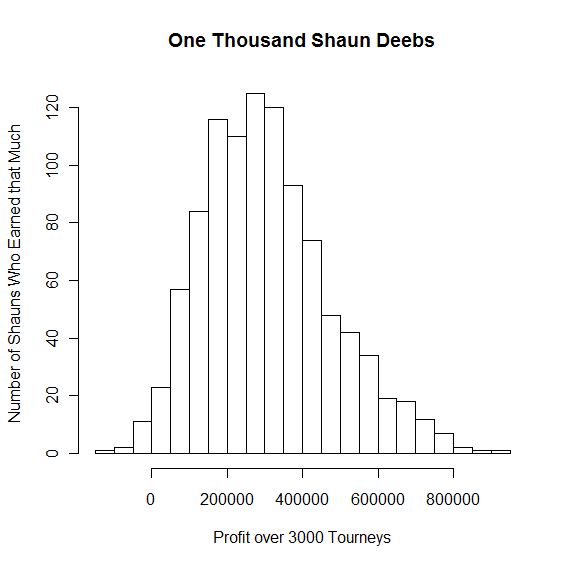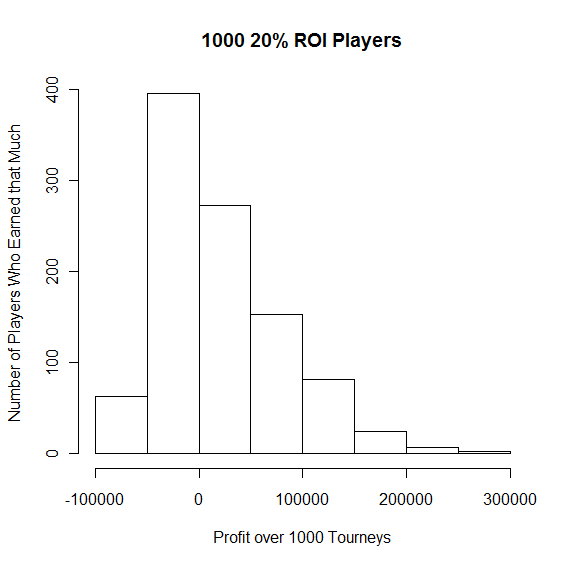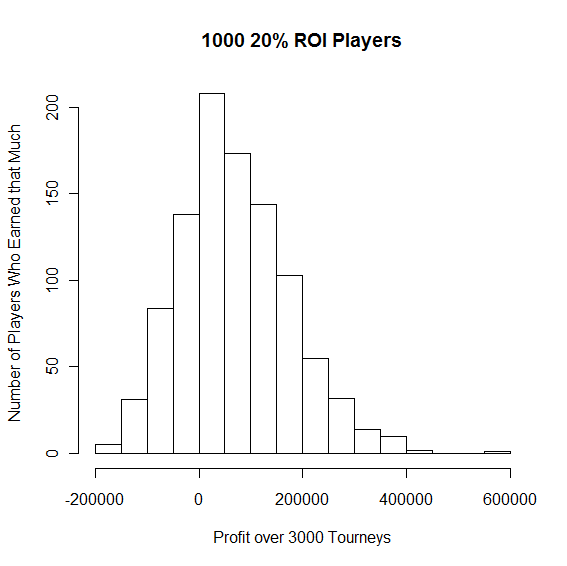(After you read this post, you might want to check out my follow-up to it here.)
I tell a lot of people not to play large-field online MTTs for a living. I’ve always thought that the variance is just way too high for most professionals to trust their livelihood (and sanity) to large-field MTTs instead of cash, smaller-field MTTs, or STTs. But, admittedly, I’ve given this advice without any direct evidence to back it up. I’ve been meaning for a while to see what the numbers say, and this post will be a tentative first step.
Ideally, what I’d like to do is do a nice controlled study where I pick a few representative players based on past results and use their results over the next few months as my data. (Alternatively, I could take the results of one of the large backing groups. If anyone who backs 20+ people would be down to share some information, let me know.) But, that requires more motivation than I’ve been able to muster, so I decided to do a much rougher study: I grabbed Shaun “SFD” Deeb’s tourney results from OPR (with Shaun’s permission) and played around for a few hours. Here’s what I found:
I used Shaun’s results from January 2009 to present on Stars and FTP. I filtered for buy-ins between $55 and $216 and included only NLHE tourneys with at least 181 entrants. OPR doesn’t record rebuys, so I removed rebuy tourneys. This left 3,049 tourneys with an average buy-in of $119.72 in which Deeb earned $294,027 with an awesome ROI of 81% and an ITM of 11.5%. Obviously, not many people can play or run as well as Shaun Deeb, but these results provide a starting point.
Say you are Shaun Deeb, you really do have an ROI of 81%, and you’re going to play 1,000 of these tourneys. What are the odds you make money? What are the odds you make at least $50k? Etc etc. Here are the results of one thousand Shaun Deebs each playing one thousand tourneys:

In particular, Shaun loses over a 1,000 tournaments sample about 13% of the time, and he makes less than $50k about 35% of the time (with an EV of about $100k). Of course, the upside is pretty good too–He makes over $200k about 14% of the time and over $300k almost 4% of the time.
Here’s the same data for a larger sample of 3,000 tournaments:

Over 3,000 tourneys, Shaun wins about 98.6% of the time, and he wins over $150k over 82% of the time. He made over $900k once in my 1,000 trials ($915,134) and over $600k about 6% of the time.
But, say you’re not Shaun Deeb. I can make a lower ROI player by simply taking Shaun’s distribution and lowering the payouts. (For an ROI of x, multiply the prizes by (1+x)*0.554 .) This isn’t very accurate, but it’s good enough for my purposes (especially since Shaun has a low ITM%). Here’s the 1,000 tourney histogram for a 20% ROI player:

As you can see, the situation is way worse. This player loses about 45% of the time and loses over $50,000 about 7% of the time. That’s pretty terrible, but maybe things get better with a larger sample? Here’s the data for 3000 Tourneys:

A 20% ROI player will be a loser over a 3,000 tourney sample almost 26% of the time. That’s much higher than I’d expected, and it’s the sort of number that should scare the shit out of prospective and current MTT professionals–If you want to play MTTs for a living, you better either put in a ton of volume, play really well, or be prepared to be a slave to variance (and nobody’s actually prepared for that).
Here’s lots of data for lots of situations (sorry for the ugly formatting):
| ROI | Tourneys Played | Expected Earn | Chance of Loss | Chance of Earning < .5x EV | Chance of Earning > 1.5x EV | Chance of Earning > 2x EV |
| 20% | 100 | $2,394.53 | 65% | 67% | 30% | 28% |
| 20% | 500 | $11,972.65 | 53% | 60% | 30% | 25% |
| 20% | 1000 | $23,945.30 | 42% | 50% | 36% | 31% |
| 20% | 2000 | $47,890.60 | 33% | 44% | 35% | 25% |
| 20% | 5000 | $119,726.50 | 20% | 38% | 30% | 17% |
| 40% | 100 | $4,789.06 | 61% | 65% | 27% | 23% |
| 40% | 500 | $23,945.30 | 37% | 51% | 31% | 26% |
| 40% | 1000 | $47,890.60 | 29% | 44% | 32% | 23% |
| 40% | 2000 | $95,781.20 | 14% | 33% | 28% | 17% |
| 40% | 5000 | $239,453.00 | 6% | 26% | 21% | 8% |
| 60% | 100 | $7,183.59 | 56% | 63% | 29% | 24% |
| 60% | 500 | $35,917.95 | 29% | 49% | 31% | 25% |
| 60% | 1000 | $71,835.90 | 20% | 41% | 27% | 18% |
| 60% | 2000 | $143,671.80 | 9% | 33% | 26% | 13% |
| 60% | 5000 | $359,179.50 | 1% | 16% | 17% | 4% |
| 80% | 100 | $9,578.12 | 51% | 62% | 25% | 21% |
| 80% | 500 | $47,890.60 | 24% | 46% | 28% | 22% |
| 80% | 1000 | $95,781.20 | 12% | 36% | 28% | 16% |
| 80% | 2000 | $191,562.40 | 5% | 27% | 23% | 9% |
| 80% | 5000 | $478,906.00 | 0% | 13% | 12% | 2% |
| 100% | 100 | $11,972.65 | 47% | 61% | 24% | 18% |
| 100% | 500 | $59,863.25 | 18% | 44% | 25% | 20% |
| 100% | 1000 | $119,726.50 | 9% | 35% | 25% | 11% |
| 100% | 2000 | $239,453.00 | 1% | 24% | 18% | 5% |
| 100% | 5000 | $598,632.50 | 0% | 8% | 10% | 1% |
There’s obviously a lot of information there, but some things jump out. In particular, life totally sucks if you’re a 20% ROI player. Even if you play 5k tourneys (which would be a decent sample for an entire year), you still have a 20% chance of losing money and a 38% chance of making less than ~60k. That totally sucks. Anyone except a true tourney god is more likely to lose over 100 tourneys than to win, which also sucks, and even a great tourney player has a decent chance of losing over 1k+ tournaments or to make only half her expected earn over 5k tournaments. Of course, the upside is good too, but the risk of losing money should be pretty scary to professional MTT players.
I should mention that this data lines up pretty well with my experience. I know a lot of professional MTT players. Losing months are incredibly common for them, and losing years happen fairly often. Years where they way underperform their expectations are typical. So, I hope people consider this before deciding to play (or continue playing) these for a living. People who are really good at MTTs, willing to put in tons of volume, and have huge bankrolls and strong stomachs might be better off playing large field MTTs professionally, but there aren’t many of those people. I think for the vast majority of people, it’s not a good idea (even for those who play very well).
You can find more data and some discussion about the distribution here and here. In future posts (probably coming soon, but I’m not making any promises), I’ll compare this data to cash games (both NLHE and PLO), STTs, and small field MTTs (i.e. 45s and 180s). I’ll also look into how stuff like this affects backing. So, if that stuff interests you, stay tuned or whatever. You can follow me on twitter if you want to know when my posts go up, or just subscribe to my RSS feed.
Interesting stuff!
As a math geek, those distributions look like Poisson distributions, which means we are looking at stuff that hasn’t converged yet. Which is exactly your point – your theoretical EV takes too long to converge realistically. If Shaun Deeb were to play “1 mirrion” tourneys, I’m sure the distribution would look much more Gaussian (as do your 5000 tourney ones) and we could operate with the usual statistical parameters.
One thing that entices some to try to go on the tourney circuit (especially live) is the possibility of endorsement deals. The fact that their Certainty Equivalent is negative (even if EV is positive), doesn’t deter them, because the parlay of scoring a sponsorship deal is huge.
I see tourneys as a prop bet similar to playing a roulette wheel with a 40-1 payout, with the caveats that you only can play one number and you HAVE to pay 1000$ (e.g.) to play. It is a +EV bet, but my bankroll is way to small to account for the swings. So I just do it once in a while for “fun” – the upside is huge!
i feel much better after reading this…i had 3 successful mtt years in a row playing huge volumes, but due to my work/life schedule, i’m limited to only a few large field mtt’s on sundays…and i’ve now had a few losing years. eventually i’ll hit a final table and everything will balance out.
i look forward to learning more about your findings.
Hey Noah,
Interesting read. I’m stacking 10 players ATM and I’m interested in the calculations you’ve used. Additionally I have accurate data from 2 years of live play of 10 players.
Robbie,
gl with the staking. I don’t think I’ll even attempt to tackle live tournaments because of how incedibly difficult it will be to get a decent sample.
Great post, I really enjoyed reading it. As a cash game guy I always suspected that large field MTTs were a variance fest. Compelling post, I’ll be reading more of your blog in the future.
Yeah, this is very relevant to me as i’m trying to become a poker pro.
thanks so much for putting this together, very sobering and eye opening and will completely change my approach. And if you like, you can follow me on my blog:
http://www.allvegaspoker.com/forum/viewtopic.php?f=27&t=13890
Thanks a lot for the work, very appreciated!
Awesome thought process.
Where do large field mtt’s start and where do smaller field mtt’s end?
Value,
It’s a continuous spectrum. The smaller the field, the lower the variance.
Nice work Noah, but could you help me understand it a little better…regarding profit for a 20% roi over 1000 tourneys…what is the average buy in assumed…
how can i plug your formulas to develop a histogram for me, say a 60% roi’er, playing an average buy in of $20, over 1k, 3k, and 5k tourneys?
thanks so much
noah, nvermind on that last note, i’m a little slow. ;-).
but i would like to see a histogram relevant to my average buy in, roi, and sample size with different ranges of earning 1.5EV and >2eV…for example, what would the percentages be at every +0.1EV increase?
Hi Jason,
Average buy-in shouldn’t really effect things. What does effect things is your spread of buy-ins. See my second post on MTTs for more on that.
How can the chance of losing be bigger than the chance of winning for a player with positive expected earnings? Because you will probably fail to make the big score that will even things out and make you a winner?
Exactly. Think about one MTT. In one MTT, a really good player loses maybe 85% of the time, even though he has a positive winrate.
Since the Hard money lenders fl option is a way for a buyer to take control of a property with very little risk for their part, the options present display a way for the buyer takes full control of a property with no risk on your part. An option is a contract of sale with a difference: when a sales contract states that “the buyer will be “buying property a certain price and terms, an option agreement to indicate that “buyer may be “buying property certain price and conditions. This gives the buyer the opportunity to buy or not buy a property in the schema specified in the contract. I try to do my choice for 90 days, but did not agree with me that the bands on the property that the length, I will go Hard money lenders fl the seller ISN as short as 60 days – but not shorter. I need at least 60 days because I want time to market and the edge.
Hey Noah.. my friend (https://twitter.com/#!/caiobritesreal) he is a backer.. he has 20ish players.. playng online MTT’s.. talk to him.. maybe he can help u